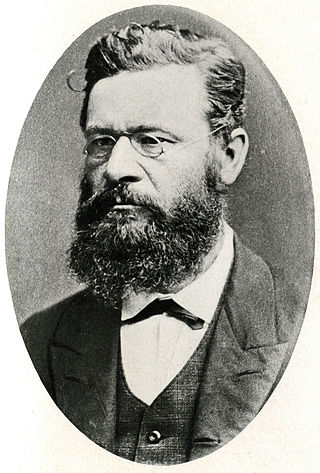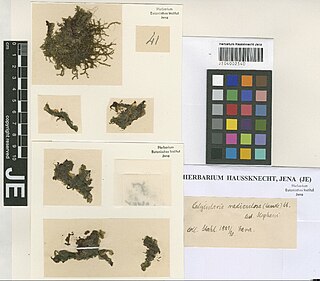
Miqueliopuntia is a monotypic, genus of cactus in the Cactaceae family, containing a single species, Miqueliopuntia miquelii(Monv.) F.Ritter., which is native to the Chilean coasts of South America.

Olof Peter Swartz was a Swedish botanist and taxonomist. He is best known for his taxonomic work and studies into pteridophytes.

Petter Adolf Karsten was a Finnish mycologist, the foremost expert on the fungi of Finland in his day, and known in consequence as the "father of Finnish mycology".
Leslie Pedley was an Australian botanist who specialised in the genus Acacia. He is notable for bringing into use the generic name Racosperma, creating a split in the genus, which required some 900 Australian species to be renamed, because the type species of Acacia, Acacia nilotica, now Vachellia nilotica, had a different lineage from the Australian wattles. However, the International Botanical Congress (IBC), held in Melbourne in 2011, ratified its earlier decision to retain the name Acacia for the Australian species, but to rename the African species.

Satakentia liukiuensis, is a species of palm tree. They are endemic to Ishigaki Island and Iriomote Island in the Yaeyama Islands, the south-westernmost of the Ryukyu Islands, Japan. It is the only species in the genus Satakentia.
Setchellanthus caeruleus is a species of pungent shrub with large blue flowers. It is placed alone in the genus Setchellanthus, which is in turn, is placed alone in the family Setchellanthaceae. It is endemic to Mexico.

Joseph-Henri Léveillé was a French physician and mycologist who was a native of Crux-la-Ville, in the department of Nièvre.
Streimannia is a genus of lichenized fungi in the family Roccellaceae. A monotypic genus, it contains the single species Streimannia varieseptata. The genus was circumscribed by Göran Thor in Opera Bot. vol.103 on page 84 in 1990.
Molleriella is a genus of fungi in the family Elsinoaceae.
Servitia is a genus of fungi in the family Verrucariaceae. A monotypic genus, it contains the single species Servitia inconspicuum(Lynge) M.S. Christ. & Alstrup. It was circumscribed in Alstrup & Hansen, Graphis Scripta vol.12 (2) on page 41 in 2001.
Ludwig Benjamin (1825–1848) was a German botanist who contributed to Carl Friedrich Philipp von Martius' Flora Brasiliensis. The genus Benjaminia is named in his honour.

Rainiera is a monotypic genus of flowering plants in the daisy family, Asteraceae. The single species, Rainiera stricta(Greene) Greene, is endemic to the northwestern United States. The genus is part of the tribe Senecioneae, and appears to be most closely related to Luina, another genus of northwestern North America, in which it was once placed. Rainiera stricta is of conservation concern, with a G2G3 ranking from NatureServe, and is considered to be globally imperiled. It is known by the common name false silverback.
Duboscquella is a genus of dinoflagellates.
Jamesiella is a genus of fungi in the family Gomphillaceae. It was circumscribed by Robert Lücking, Emmanuël Sérusiaux and Antonín Vězda in 2005. The genus name honours Peter Wilfrid James, an English botanist who worked at the Natural History Museum, London. The type species of the genus, Jamesiella anastomosans, is now classified in the genus Gyalideopsis.

The Mixiomycetes are a class of fungi in the Pucciniomycotina subdivision of the Basidiomycota. The class contains a single order, the Mixiales, which in turn contains a single family, the Mixiaceae that circumscribes the monotypic genus Mixia. Only one species has been described to date, Mixia osmundae; this species was originally named Taphrina osmundae by Japanese mycologist Toji Nishida in 1911. It is characterized by having multinucleate hyphae, and by producing multiple spores on sporogenous cells.

Sandeothallus is a small genus of liverworts restricted to East Asia. It is classified in the order of Pallaviciniales and is the only member of the family, Sandeothallaceae within that order.

Carlo Luigi Spegazzini, in Spanish Carlos Luis Spegazzini, was an Italian-born Argentinian botanist and mycologist.
Fischerula is a genus of two truffle-like fungi in the family Morchellaceae. First described from central Italy by Oreste Mattirolo in 1928, the genus name honors Swiss mycologist Eduard Fischer. The type species Fischerula macrospora is known only from Italy, while Fischerula subcaulis is found in coniferous and mixed forests of Oregon and Washington.
Goebeliellaceae is a family of liverworts belonging to the order Porellales. The family consists of only one genus: GoebeliellaSteph..
Herzogianthaceae is a family of liverworts belonging to the order Ptilidiales. The monotypic family consists of only one genus: HerzogianthusR.M.Schust..









